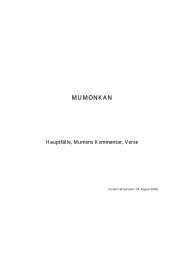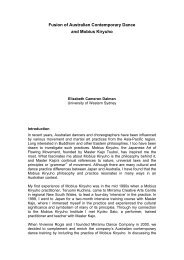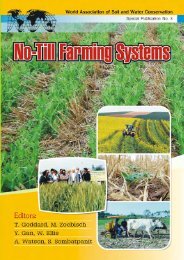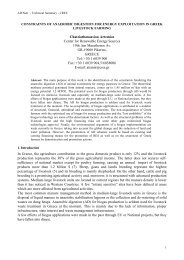Process design of agricultural digesters - nifty
Process design of agricultural digesters - nifty
Process design of agricultural digesters - nifty
You also want an ePaper? Increase the reach of your titles
YUMPU automatically turns print PDFs into web optimized ePapers that Google loves.
<strong>Process</strong> <strong>design</strong> <strong>of</strong> <strong>agricultural</strong> <strong>digesters</strong><br />
Arthur Wellinger<br />
Table <strong>of</strong> content<br />
1. Introduction<br />
2. A short history <strong>of</strong> anaerobic digestion<br />
3. The process parameters<br />
3.1 Temperature<br />
3.2 Hydraulic Retention time<br />
3.3 Organic loading rate<br />
3.4 Ammonia concentration<br />
4. <strong>Process</strong> control<br />
5. <strong>Process</strong> <strong>design</strong><br />
5.1 Mode <strong>of</strong> feeding<br />
5.2 Substrate characteristics<br />
5.3 Mixing<br />
5.4 Pumping<br />
6. Pre- and post-treatment<br />
Document1<br />
Nova Energie GmbH<br />
Elggerstrasse 36<br />
8356 Ettenhausen<br />
Tel. 052 368 34 70<br />
Fax 052 365 43 20<br />
E-mail<br />
<strong>of</strong>fice.ettenhausen@<br />
novaenergie.ch<br />
Ettenhausen, 1.11.99
1. Introduction<br />
The three areas <strong>of</strong> interest to most potential purchasers <strong>of</strong><br />
anaerobic <strong>digesters</strong> for use on farms are pollution control<br />
(reduction <strong>of</strong> methane emission odour control), improvement <strong>of</strong><br />
manure quality as a fertiliser and energy production. With energy<br />
production as the major objective there is likely to be more<br />
technical equipment and <strong>design</strong> needed for producing a maximum<br />
amount <strong>of</strong> gas and its efficient utilisation than is needed for a<br />
digester which is <strong>design</strong>ed primarily for pollution control. In practice<br />
<strong>digesters</strong> are usually required to meet all three objectives. Even<br />
though pollution control might be the driving force to construct a<br />
digester, the energy is the interesting part to financially support the<br />
cost <strong>of</strong> the installation.<br />
In the USA pollution control becomes an important argument to<br />
build a digester within the AgStar program <strong>of</strong> the EPA, the USDA<br />
and the DOE, much more than energy production. Sales prices <strong>of</strong><br />
electricity <strong>of</strong> lower than 3 cts per kWh are sufficient to stimulate<br />
interest purely on the basis <strong>of</strong> energy . In parts <strong>of</strong> the European<br />
Union on the other hand - in particular in Denmark, Germany,<br />
Luxembourg and Austria - the on-farm energy production is an<br />
important income for many farmers due to a number <strong>of</strong> positive<br />
income and operation factors including:<br />
• High electricity prices for renewable energies<br />
• State subsidies<br />
• Optimised <strong>design</strong>s based on modular constructions<br />
• Utilisation <strong>of</strong> serial parts<br />
• Reduced material cost thanks to collective purchase and<br />
construction <strong>of</strong> farm-scale plants<br />
• Do-it-yourself construction with the help <strong>of</strong> engineers<br />
• Co-fermentation <strong>of</strong> organic waste from household and industry<br />
bringing additional income from gate fee and through higher gas<br />
production<br />
• Availability <strong>of</strong> proven low-cost, turn-key installations due to<br />
higher competition among manufacturers<br />
• Centralised biogas plants<br />
Document1 2
2. A short history <strong>of</strong> Anaerobic Digestion<br />
Anectodal evidence indicates that biogas was used for heating<br />
bath water in Assyria during the 10 th century BC and in Persia<br />
during the 16 th century BC (Lusk, 1998).<br />
The science <strong>of</strong> AD is as old as scientific research can be and<br />
includes the names <strong>of</strong> world's most famous searchers: Benjamin<br />
Franklin described as early as 1764 that he was able to light a<br />
large surface <strong>of</strong> a shallow muddy lake in New Jersey. This<br />
experiment was reported in a letter to Joseph Priestly in England<br />
who published in 1790 his own experiences with the inflammable<br />
air (Titjen, 1975).<br />
Alexander Volta was the first researcher describing the formation <strong>of</strong><br />
inflammable gases in (low-temperature) marshes and lake<br />
sediments scientifically. His letters on the formation <strong>of</strong> "Aria<br />
inflammabile nativa delle Paludi" where published in Italy in 1776.<br />
The importance <strong>of</strong> these findings was fully recognised by the<br />
scientific community, which is reflected by the fact that his letters<br />
were translated into German only two years after their appearance<br />
(Volta, 1778). In 1804, Dalton gave the correct chemical formula for<br />
methane.<br />
The oldest publication <strong>of</strong> the temperature influence on methane<br />
formation was written by Pop<strong>of</strong>f (1875). He found that river<br />
sediments could form biogas at temperatures as low as 6°C. With<br />
increasing temperature up to 50°C the gas production was<br />
stimulated. He also observed that the composition <strong>of</strong> the gas<br />
formed did not change with temperature.<br />
The first digestion plant was built at a leper colony in Bombay,<br />
India in 1859 (Meynell, 1976). Gayon, a pupil <strong>of</strong> Pasteur, recorded<br />
a success in his experiments with animal manure in 1883-84<br />
(Titjen, 1975). The volume <strong>of</strong> gas collected at 35°C was so great<br />
that Louis Pasteur concluded anaerobic manure fermentation might<br />
supply gas for heating and illumination under special<br />
circumstances. But the proposal, made in jest by the newspaper<br />
"Le Figaro" to improve the street illumination <strong>of</strong> Paris by manure<br />
fermentation from the numerous horses <strong>of</strong> the taxis and public<br />
works was not executed.<br />
Document1 3
Based on the findings that higher temperatures stimulate the<br />
biogas formation, heating systems were developed to increase the<br />
digester temperature. In particular, Imh<strong>of</strong>f and Blunk patented<br />
between 1914 and 1921 a number <strong>of</strong> procedures such as internal,<br />
double walled heat exchangers, addition <strong>of</strong> hot water to the fresh<br />
sludge, steaming <strong>of</strong> the digester content or injection <strong>of</strong> hot biogas.<br />
However, considerable technical problems prevented the full-size<br />
application <strong>of</strong> their inventions: internal heat exchangers<br />
(particularly those made in copper) corroded within no time, and<br />
the addition <strong>of</strong> water or steam led to an undesired dilution <strong>of</strong> the<br />
sludge. Hence, the Imh<strong>of</strong>f-tank (Emscherbrunnen) working at<br />
ambient temperatures, still gave the best results. However, the<br />
start <strong>of</strong> the first continuously heated digester in 1926 in Essen<br />
(Roediger, 1955) indicated the break through <strong>of</strong> high temperature<br />
industrial digestion (mesophilic or thermophilic).<br />
In the world <strong>of</strong> AD technology, farm based facilities are the most<br />
common. In China alone four to six million family-sized, low<br />
technology <strong>digesters</strong> are used to provide biogas for cooking and<br />
lighting and to sanitise the manure and the night-soil.<br />
One <strong>of</strong> the most significant scientific developments in <strong>agricultural</strong><br />
biogas goes back to the thirties when Buswell made his basic<br />
experiments on manure digestion in combination with most<br />
possible types <strong>of</strong> organic waste (Buswell and Hatfield, 1936).<br />
Buswell became the father <strong>of</strong> co-digestion.<br />
The first full-scale (albeit small, approx. 10 m 3 ) <strong>agricultural</strong> biogas<br />
installation developed in 1938 by Isman and Ducellier in Algeria<br />
(van Brakel, 1980) was operated on solid waste. However, the<br />
further development <strong>of</strong> the solid waste system was stopped during<br />
world war II.<br />
Towards the end <strong>of</strong> the second world war when the fuel was<br />
limited, AD <strong>of</strong> liquid manure and sewage sludge became quite<br />
popular again (Fig. 1 & 2). In France, more than 40 small-scale,<br />
mostly batch <strong>digesters</strong> were operated. The number increased to<br />
800 in the fifties (van Brakel, 1980). In Germany some 48 facilities<br />
<strong>of</strong> rather large size and high technical standard mainly on sewage<br />
works were put in operation (Titjen, 1975). Half <strong>of</strong> the gas was<br />
utilised to run vehicles.<br />
Document1 4
Today, biogas production has become a standard technology in<br />
waste water treatment and upgrading <strong>of</strong> biowaste from household<br />
and agriculture. The developments <strong>of</strong> the last 20 years allows not<br />
only low-cost gas production but also its upgrading and efficient<br />
utlisation in gas engines to produce electricity and fuel vehicles<br />
(Wellinger and Lindberg, 1999).<br />
Figure 1: Gas yield <strong>of</strong> sewage sludge in function <strong>of</strong> HRT and<br />
temperature.<br />
Document1 5
Figure 2: Gas yield <strong>of</strong> straw-rich solid cattle waste in function <strong>of</strong><br />
HRT and Temperature<br />
3. The process parameters<br />
The anaerobic degradation <strong>of</strong> organic substances to its most<br />
reduced form, methane (CH4) is a purely microbial process. The<br />
energy released during the degradation steps which was originally<br />
stored in the substrate is predominantly recovered by the methane<br />
formed (equation 1). This distinguishes the process from aerobic<br />
degradation, where the energy is predominantly recovered in new<br />
biomass and carbon dioxide (CO2) and some low temperature<br />
excess heat (equation 2). All three forms are not suitable for a<br />
technical utilisation <strong>of</strong> the energy.<br />
Document1 6
Anaerobic degradation:<br />
33g org. material (CH2O) = 22g CO2 + 8g CH4 + 3g biomass<br />
(equation 1)<br />
Aerobic degradation:<br />
33g org. material (CH2O) + 12.8g oxygen = 17.6g CO2 + 7.2g H2O +<br />
21g biomass<br />
(equation 2)<br />
The anaerobic degradation is not a one step process. It occurs in<br />
three steps by at least four different groups <strong>of</strong> bacteria.<br />
Step 1: Hydrolysis<br />
In a first step the solid material, i.e. the complex and long chain<br />
substrates are broken down by exo-enzymes to soluble molecules<br />
which are taken up by the bacteria.<br />
Step 2: Fermentation<br />
The products <strong>of</strong> the hydrolysis are degraded by fermentative<br />
bacteria predominantly to volatile fatty acids (VFA)<br />
Step 3: Methane formation<br />
Approximately 70% <strong>of</strong> the methane is formed from VFA, 30% from<br />
hydrogen and CO2 by methanogenic bacteria.<br />
The thermodynamic limits <strong>of</strong> anaerobic digestion are very narrow.<br />
The formation <strong>of</strong> methane is only maintained as long as all the<br />
bacterial consortia involved in the chain are working under optimal<br />
conditions. Some <strong>of</strong> the degradation steps will not yield energy<br />
unless their products are efficiently removed by the next group <strong>of</strong><br />
bacteria. The bottleneck is propionic acid, which is only degraded<br />
when the hydrogen in the system is cleaved by the methanogens.<br />
As a consequence, there are few parameters which allow the<br />
process to be controlled. In fact, there are only four parameters<br />
which can be altered within limits.<br />
Document1 7
3.1 Temperature<br />
Methane is formed in nature over a wide temperature range from<br />
close to freezing (Mc Ghee, 1968) e.g. sewage in the arctic, up to<br />
over 100°C such as in the steams <strong>of</strong> Geyers (Zillig et al., 1981).<br />
In technical applications three different temperature ranges are<br />
distinguished:<br />
• Psychrophilic temperature (or cryophilic)<br />
from 10° to 25°C<br />
• Mesophilic temperature<br />
• Thermophilic temperature<br />
from 25° to 35°C<br />
from 49° to 60°C<br />
A number <strong>of</strong> mesophilic and thermophilic anaerobic bacteria are<br />
described in the literature with temperature optima between 28°<br />
and 42°C and between 55° and 72°C respectively. So far no<br />
anaerobic psychrophilic bacteria have been found with a relative<br />
temperature maximum below 25°C. The work <strong>of</strong> Zeemann et al.<br />
(1988) and Wellinger et al. (1985) rather suggest a slow adaptation<br />
<strong>of</strong> mesophilic bacteria to lower temperatures.<br />
The methanogenic bacteria seem to be ubiquitous at least in all<br />
anaerobic environments and obviously survive a wide temperature<br />
range.<br />
It is therefore not surprising to find that the change from mesophilic<br />
to thermophilic temperatures or vice versa is not a problem in<br />
animal waste <strong>digesters</strong> as long as the change occurs smoothly<br />
(slow change, low loading). However, it might take months before<br />
mesophilic cultures are adapted to psychrophilic temperatures.<br />
Once the adaptation to low temperatures is complete, the system<br />
reacts very well to stress situations (Wellinger et al., 1985).<br />
The ultimate gas yield <strong>of</strong> psychrophilic digestion is lower than at<br />
mesophilic temperatures. Differences reported are in the range <strong>of</strong><br />
30% for cattle manure (Wellinger et al. 1985) and 22% for sewage<br />
sludge (Maly and Fadrus, 1971).<br />
Document1 8
Within practical time limits (up to 100 days) it was found that the<br />
degradation at 22°C <strong>of</strong> sewage sludge (Fair and Moore, 1934),<br />
cattle manure (Wellinger et al., 1985) and swine manure (Stevens<br />
and Schulte, 1979) takes about two times longer than at 35°C.<br />
On the other hand, there is hardly any difference between<br />
mesophlic and thermophilic digestion. Obviously there is a faster<br />
degradation at the higher temperatures as was shown by Maly and<br />
Fadrus (1971; Fig. 1) for sewage sludge and Baserga et al. (1995)<br />
for solid animal waste (Fig. 2), but ultimate gas yields are fairly<br />
comparable.<br />
Until the late eighties when the biogas was used for heating<br />
purposes only, psychrophilic <strong>digesters</strong> were quite popular. Suter<br />
and Wellinger (1987) demonstrated that the net heat production <strong>of</strong><br />
mesophilic <strong>digesters</strong> was lower than that <strong>of</strong> psychrophilic <strong>digesters</strong><br />
when operated at 23°C. Low temperature digestion in covered<br />
lagoons is still applied in the USA (Lusk, 1998).<br />
When the price paid for the production <strong>of</strong> electricity from renewable<br />
energy was increased after 1990 in a number <strong>of</strong> European<br />
countries most <strong>of</strong> the biogas installations were equiped with<br />
combined heat and power plants (CHP). Since they produce<br />
excess heat during most <strong>of</strong> the year the majority <strong>of</strong> the <strong>agricultural</strong><br />
plants are currently operated at mesophilic temperatures.<br />
Thermophilic temperatures are applied in most <strong>of</strong> the large-scale<br />
centralised biogas plants with co-digestion, where more stringent<br />
sanitation requirements are required.<br />
3.2 Hydraulic retention time<br />
The hydraulic retention time (HRT) describes the average time the<br />
substrate remains in a digester. It is defined by<br />
HRT = liquid volume m 3 .d in days.<br />
daily flow m 3<br />
Document1 9
In a continuous-flow digester HRT has to be longer than the<br />
doubling time <strong>of</strong> the bacteria to prevent wash-out.<br />
The minimal HRT is dependent on the type <strong>of</strong> material to be<br />
digested. The lower the degradation rate, the slower the doubling<br />
time <strong>of</strong> the bacteria, the higher the HRT. The rate limiting step for<br />
<strong>agricultural</strong> waste usually is the hydrolysis. The velocity <strong>of</strong><br />
degradation <strong>of</strong> the basic classes <strong>of</strong> compounds increases in the<br />
following order:<br />
• Cellulose<br />
• Hemicellulose<br />
• Proteins<br />
• Fat<br />
• Carbohydrates<br />
As a result, the digestion <strong>of</strong> pig manure with its high fat content<br />
requires lower HRTs than cattle manure which contains<br />
comparably high cellulose and hemi-cellulose concentrations.<br />
Average HRTs for mesophilic digestion are:<br />
Cattle manure 12 to 18 days<br />
Cattle manure with straw bedding 18 to 36 days<br />
Pig manure 10 to 15 days<br />
Even though lipids (fat) are fairly rapidly degraded they may be the<br />
reason for problems with inhibition. Lipids and their hydrolysis<br />
products, the long chain fatty acids (LCFA), might absorb to<br />
surfaces and as such hinder (physically) the attack <strong>of</strong> exo-enzymes<br />
which hydrolyse the substrate and the transport <strong>of</strong> substrates<br />
through bacterial membranes (Demeyer and Henderickx, 1967;<br />
Hanaki et al., 1981; Rinzema, 1988). High concentrations <strong>of</strong> LCFA<br />
are also known to inhibit its own degradaton (β-oxidation; Hanaki et<br />
al., 1981) and also methane formation (Hanaki et al., 1981;<br />
Angelidaki et al., 1990; Angelidaki and Ahring, 1992).<br />
As mentioned above, there is also a close relation between<br />
temperature and optimal HRT. O'Rourke (1968) found that the<br />
degradaton <strong>of</strong> VFA in sewage sludge becomes the rate limiting<br />
step at lower temperatures. Wellinger et al. (1985) comfirmed the<br />
Document1 10
findings with cattle waste. In continuous-flow <strong>digesters</strong> operated at<br />
18° and 14°C respectively. VFA concentrations started to increase<br />
when HRT dropped below 30d (Fig. 3) with a subsequent decrease<br />
<strong>of</strong> gas yield.<br />
Figure 3: Gas yield and acetate concentration from cattle manure<br />
in function <strong>of</strong> HRT and temperature<br />
Document1 11
3.3 Organic loading rate<br />
The organic loading rate (OLR) describes the amount <strong>of</strong> organic<br />
material (expressed as COD or Volatile Solids (VS)) which is fed<br />
daily per m 3 <strong>of</strong> digester volume. For <strong>agricultural</strong> <strong>digesters</strong> it is<br />
usually defined as:<br />
OLR = daily flow * VS-conc. = VS-conc. kg<br />
liquid volume HRT m 3 .d<br />
Optimal OLR for mesophilic reactors<br />
cattle manure 2.5 - 3.5 kg VS/m 3 .d<br />
cattle manure with co-substrates 5.0 - 7.0 kg VS/m 3 .d<br />
pig manure 3.0 - 3.5 kg VS/m 3 .d<br />
If heavy loads <strong>of</strong> co-substrates are occasionally fed into the<br />
digester it is advisable to decrease the basic OLR to lower values<br />
than indicated.<br />
Due to particular subsidy regulations in Germany (the larger the<br />
reactor the more subsidies independent <strong>of</strong> the amount <strong>of</strong> manure)<br />
most <strong>of</strong> the newer farm-scale <strong>digesters</strong> are too big with OLR<br />
around or below 1 kg VS/m 3 .d and HRTs beyond 50 days.<br />
The corresponding installations in Denmark are operated with OLR<br />
between 1.7 and 8.0 kg VS per m 3 .d at HRTs <strong>of</strong> 12 to 35 day<br />
(Energistyrelsen, 1999).<br />
3.4 Ammonia concentration<br />
Ammonia has been known for many years as a potent inhibitor <strong>of</strong><br />
methanogenesis. A number <strong>of</strong> publications seem to indicate that<br />
the free ammonium form (NH3) rather than ammonia (NH4 + ) is the<br />
real inhibitor (e.g. Kroeker et al., 1979). This means that the pH<br />
and the temperature (via pH-value) have a strong effect on the<br />
inhibitory concentration by influencing the equilibrium. Angelidaki<br />
Document1 12
and Ahring (1994) defined an upper limit <strong>of</strong> 0.7g/l <strong>of</strong> NH3 in their<br />
experiments with thermophilic digestion <strong>of</strong> manure.<br />
When digesting solid slaughterhouse waste with blood, Wellinger<br />
and Fruteau (1998) found upper limits <strong>of</strong> 3.5 g/l <strong>of</strong> ammonia<br />
corresponding to approx. 150 mg NH3/l <strong>of</strong> sludge.<br />
There is strong evidence that ammonium inhibits the methane<br />
formation from VFA (Zeemann et al., 1985). Hence, inhibition <strong>of</strong><br />
methane formation is always accompanied by an increase <strong>of</strong> VFA.<br />
There is a considerable adaptation <strong>of</strong> the bacterial consortia to high<br />
ammonia values possible. In his experiments with pig manure Van<br />
Velsen (1979) demonstrated an adaptation to concentrations<br />
higher than 6000 mg/l <strong>of</strong> ammonia-N. Koster and Lettinga (1988)<br />
found microbial activity up to 16g/l <strong>of</strong> ammonia despite heavy<br />
inhibition.<br />
Spontaneous changes in NH3-concentrations even at low levels<br />
might lead to inhibition <strong>of</strong> non adapted cultures when digesting<br />
cattle manure (Wellinger, 1985).<br />
In <strong>agricultural</strong> biogas plants ammonia concentrations are <strong>of</strong><br />
concern when protein rich co-substrate is digested such as<br />
slaughterhouse waste or waste from collective kitchen. Some <strong>of</strong> the<br />
proteins have degradation rates <strong>of</strong> more than 80%. A widespread<br />
sign <strong>of</strong> protein overloading - beside reduced methane formation - is<br />
an increase in VFA-concentrations and massive foaming.<br />
4. <strong>Process</strong> Control<br />
<strong>Process</strong> control has never been <strong>of</strong> major concern in farm-scale<br />
digestion <strong>of</strong> animal manures. Usually the <strong>digesters</strong> were planned<br />
according to the daily amount <strong>of</strong> manure fed into the digester.<br />
Since the number <strong>of</strong> animals in individuals farms has decreased in<br />
recent years, overloading <strong>of</strong> <strong>digesters</strong> rarely occurrs.<br />
The situation changed, however, when farmers started to digest cosubstrates<br />
(Steffen and Braun, 1998). This rapidly resulted in<br />
Document1 13
changes in composition <strong>of</strong> the feed as well as the volume, which<br />
varied from day to day. In particular in centralised biogas facilities<br />
process imbalance due to organic overloading or because <strong>of</strong><br />
inorganic or organic inhibitors became a matter <strong>of</strong> concern.<br />
Traditionally biogas production was the only parameter which was<br />
monitored daily, sometimes together with the CO2-content. In rare<br />
cases pH was measured as well because it was easy to determine.<br />
However, pH is a very poor indicator in highly buffered substrates<br />
such as <strong>agricultural</strong> wastes. It was found to vary only by 0.5 units<br />
even after severe accumulation <strong>of</strong> more than 8000 ppm VFA<br />
(Angelidaki and Ahring, 1994).<br />
Biogas production is still a fairly good parameter at least when the<br />
amount and the composition <strong>of</strong> the feed remains more or less<br />
constant. Because production is not a very sensitive parameter it is<br />
<strong>of</strong>ten too late for corrections when the production drops.<br />
Occasionally the composition <strong>of</strong> the gas (% <strong>of</strong> methane) is a good<br />
indicator. Usually the methane concentration drops when the<br />
process is imbalanced. However, since the CO2-concentration is<br />
also strongely influenced by the feed composition a change <strong>of</strong>ten<br />
reflects just a change <strong>of</strong> substrate.<br />
The concentration <strong>of</strong> VFA has been recognised for a long time to<br />
be an important control parameter for AD (e.g. Chynoweth and<br />
Mah, 1971; McCarty and McKinney, 1961). Many investigators<br />
have correlated the process stability to the concentrations <strong>of</strong><br />
individual VFA (Varel et al., 1977; Kaspar and Wuhrmann, 1978).<br />
All these absolute figures became useless when co-digestion was<br />
introduced. The reason is that increased ammonia concentrations<br />
or salts (NaCl), as is found in food waste, will increase the basic<br />
level <strong>of</strong> VFA anyway. Ahring and Angelidaki (1997) suggested,<br />
therefore, monitoring <strong>of</strong> the relative changes <strong>of</strong> VFA<br />
concentrations, in particular that <strong>of</strong> butyrate or iso-butyrate instead.<br />
The disadvantage <strong>of</strong> all VFA measurements is the high price <strong>of</strong> the<br />
analysis by gas chromatography and the fact that highly trained<br />
Document1 14
staff have to be at the site. Determinations in a specialised<br />
laboratory take two to three days before the data are available<br />
which is <strong>of</strong>ten too long for a proper process control and regulation.<br />
A number <strong>of</strong> years ago Rozzi and Labellarte (1984) suggested to<br />
monitor the alkalinity, a method which has been continuously<br />
improved and is now commercially available for on-line monitoring.<br />
5. <strong>Process</strong> <strong>design</strong><br />
A biogas plant usually involves more than just a gas tight manure<br />
pit or a digestion vessel. A farm-type operation usually is built up <strong>of</strong><br />
four elements (Fig. 4):<br />
(1) The production unit, which includes the manure removal<br />
system, possibly an influent holding tank and/or a sanitation unit<br />
and the anaerobic digester,<br />
(2) the safety and gas upgrading equipment,<br />
(3) the gas storage facilities and<br />
(4) the equipment for gas and manure utilisation.<br />
There are countless types <strong>of</strong> <strong>design</strong>s for each <strong>of</strong> the four elements.<br />
Some <strong>of</strong> the more widespread <strong>design</strong>s are highlighted in the<br />
following text.<br />
The core <strong>of</strong> a biogas plant is the anaerobic reactor. The art <strong>of</strong><br />
building low-cost, reliable <strong>digesters</strong> is strictly dependent on the<br />
optimal adaptation <strong>of</strong> the <strong>design</strong> to the type <strong>of</strong> substrate. A wide<br />
variety <strong>of</strong> AD systems have been developed for the digestion <strong>of</strong><br />
biowaste and other organic residues. Each has its own speciality<br />
and constraints. There is no installation which could digest all the<br />
organic waste fractions in an optimal way. The two major <strong>design</strong><br />
criteria are the mode <strong>of</strong> feeding and the substrate characteristics<br />
(dry matter, suspended solids, etc).<br />
Document1 15
Figure 4: The four basic elements <strong>of</strong> a biogas installation<br />
5.1 Mode <strong>of</strong> feeding<br />
Basically, we distinguish between three genuine modes <strong>of</strong> feeding:<br />
Batch-fed, continuous-flow and accumulation systems.<br />
In batch-systems the fresh substrate is fed together with an<br />
inoculum (approx. 10%) <strong>of</strong> digested material into a reaction vessel.<br />
During one to two days the material is aerated (composted) in<br />
order to increase the temperature. During the following three to<br />
four weeks the substrate is anaerobically degraded, at first with an<br />
increasing daily gas production. After having reached a maximum<br />
after approximately 10 to 14 days gas production decreases again<br />
to reach a plateau <strong>of</strong> about half maximum production.<br />
To compensate the unsteady gas formation three to four batch<br />
<strong>digesters</strong> are operated in parallel but filled at different times.<br />
The system is most <strong>of</strong>ten used for the digestion <strong>of</strong> straw-rich solid<br />
waste. In order to maintain digestion temperature and to moisten<br />
Document1 16
the solid waste, part <strong>of</strong> the liquid present in the digester is sucked<br />
from the bottom, pumped through a heat exchanger and recycled<br />
to the top <strong>of</strong> the digester.<br />
Accumulation continuous-flow (ACF-) systems are kind <strong>of</strong> fedbatch<br />
<strong>digesters</strong> where the reactor serves at the same time as<br />
manure pit. The fresh manure flows into the digester as it is<br />
produced. The digested manure is removed occasionally when it is<br />
needed for fertilisation. In times (winter) when no fertiliser is<br />
needed the full digester overflows into a holding tank which is <strong>of</strong>ten<br />
covered by a rubber membrane serving as a gas storage (Fig. 5).<br />
Figure 5: A modern type <strong>of</strong> ACF-system.<br />
It is actually the most popular digester <strong>design</strong> in<br />
Germany.<br />
Document1 17
The system was originally <strong>design</strong>ed for farms which had to<br />
increase their manure storage capacity (Suter and Wellinger,<br />
1987). Nowadays the system is widespread on individual farms in<br />
Germany, Luxembourg and Austria because it allows a low cost<br />
do-it-yourself construction.<br />
The most applied digester system is the continuous-flow tank<br />
reactor. The raw waste is pumped regularly into a digester,<br />
displacing an equal volume <strong>of</strong> digested material. The volume in the<br />
digester remains constant. Most <strong>of</strong> the smaller systems are fed<br />
once or twice a day. The larger digester are operated more<br />
continuously with feeding intervals <strong>of</strong> less than one hour.<br />
5.2 Substrate characteristics<br />
The <strong>design</strong> <strong>of</strong> a digester is strongly influenced by the substrate<br />
characteristics, i.e. the homogeneity and the dry matter content <strong>of</strong><br />
the waste. Waste water low in total and suspended solids is<br />
usually found in food factories, etc. It can be upgraded in high-rate<br />
<strong>digesters</strong> such as upflow anaerobic sludge blankets (UASB) or<br />
anaerobic filters (AF; packed bed reactors).<br />
The idea behind high-rate systems is to increase the biomass<br />
(bacteria) in the digester to maintain a high degradation rate. This<br />
is achieved either by packed bed reactors <strong>of</strong>fering a surface where<br />
the bacteria can attach and/or are withhold under non-turbulent<br />
conditions by the packing. Therefore the term "filter" is used.<br />
The UASB make use <strong>of</strong> the phenomenon that anaerobic bacteria<br />
tend to develop small clumps (granules) which manifest high<br />
settling velocities and remain in the digester.<br />
For <strong>agricultural</strong> wastes rich in solid material the high-rate reactors<br />
are not suitable: granule formation is hindered and packed beds<br />
will clog immediately. Exceptions include waste water from silage<br />
or supernatant <strong>of</strong> pig manure (Colleran et al., 1983), where good<br />
results were achieved.<br />
Animal waste which is the predominant waste material in<br />
<strong>agricultural</strong> digestion is an inhomogeneous material with total solid<br />
concentrations between 2% and 12%. The predominant number <strong>of</strong><br />
manure <strong>digesters</strong> is therefore <strong>of</strong> the type <strong>of</strong> a continuously stirred<br />
Document1 18
tank reactor (CSTR). This type is also well suited for co-digestion<br />
systems, <strong>of</strong>ten combined with an influent holding tank.<br />
There is a wide range <strong>of</strong> construction material available particularly<br />
for above ground constructions such as concrete, steel, glass fibre<br />
reinforced plastic and wood.<br />
Continuously-fed solid waste digestion has become a standard<br />
technology for the upgrading <strong>of</strong> source separated household waste.<br />
More than 50 installations <strong>of</strong> different <strong>design</strong>s (horizontal and<br />
vertical plug-flow, gas-stirred tank reactor, sequencing batch<br />
reactor) are successfully operated in Europe (Lusk, 1997).<br />
For <strong>agricultural</strong> solid wastes however, only a pilot plant <strong>of</strong> 10 m 3<br />
was in operation at the FAT in Switzerland for a number <strong>of</strong> years<br />
(Baserga, Egger and Wellinger, 1994) as well as a limited number<br />
<strong>of</strong> small batch <strong>digesters</strong> (Membrez, 1998). No full-scale plant has<br />
been described so far. The reason for this limited success is the<br />
economic viability. The only income <strong>agricultural</strong> solid waste<br />
<strong>digesters</strong> is the gas produced resp. the electricity sold, where as<br />
for household waste a tipping fee can be recovered.<br />
5.3 Mixing<br />
The substrate in an <strong>agricultural</strong> biogas digester is usually mixed<br />
intermittently in time intervals ranging from several times daily to<br />
several times per hour. The power applied for mixing varies in<br />
function <strong>of</strong> size and form <strong>of</strong> the digester and the composition <strong>of</strong> the<br />
substrate. It covers the range from 10 to 100 wh/m 3 .d. Usually a<br />
value <strong>of</strong> more than 30 wh/m 3 .d is recommended.<br />
There are several reasons for mixing:<br />
• Inoculation <strong>of</strong> the fresh substrate with digestate<br />
• Distribution <strong>of</strong> heat to achieve an even temperature through out<br />
the digester<br />
• Avoid or disrupt scum and sediment formation<br />
• Release <strong>of</strong> biogas bubbles trapped in the substrate<br />
If the substrate is not mechanically mixed it tends to separate, i.e. it<br />
forms a sediment and a scum. The scum is particularly difficult to<br />
remove after it has dried out through continuous gas production.<br />
Document1 19
As long as the particles floating to the top are incorporated into the<br />
liquid phase, they remain wet and s<strong>of</strong>t and can easily be removed.<br />
In larger <strong>digesters</strong> usually two to three mixers are applied in<br />
different depths <strong>of</strong> the digester. In small-size family plants only one<br />
stirrer is installed for economical reasons. It is therefore important<br />
that it is adjustable for the mixing <strong>of</strong> a possible scum and sediment<br />
formation (Fig. 6.).<br />
A B<br />
C D<br />
E F<br />
Figure 6: Different types <strong>of</strong> mixing (Schulz, 1996)<br />
A: Horizontal paddle stirrer E: Hydraulic mixing<br />
B: Vertical paddle stirrer F: Air lift<br />
C: Adjustable propeller mixer<br />
D: Propeller miser on a swivel arm<br />
Document1 20
An equally important characteristic <strong>of</strong> stirring is the mixing <strong>of</strong> the<br />
cold influent with the warm material under degradation. It is<br />
obvious that the raw waste is inoculated with the anaerobic<br />
bacteria in the digester. But at the same time it is heated. If the<br />
temperature remains low no bacterial activity will take place for an<br />
extended period.<br />
For all the mixing purposes mentioned, the speed <strong>of</strong> rotation is not<br />
important. Usually slowly rotating mixers are applied with rotations<br />
as low as 15-50 rpm.<br />
Again, not all types <strong>of</strong> stirrers are equally well adapted for all<br />
possible substrates. Hydraulic and pneumatic stirrers are restricted<br />
to dilute substrates such as pig manure with little potential for scum<br />
formation. A horizontal paddle stirrer, on the other hand, is<br />
especially well <strong>design</strong>ed for straw-rich cattle manure. However, it<br />
can also handle more dilute substrates.<br />
The most widely used stirrer are the propeller mixers. They allow<br />
the most flexible application with respect to the substrate<br />
composition and the form and size <strong>of</strong> the digester.<br />
The only limit is the temperature for submerged motors. Above a<br />
fermentation temperature <strong>of</strong> 40°C there is not enough cooling.<br />
5.4 Pumping<br />
Pumping <strong>of</strong> manure and similarly inhomogeneous substrates is a<br />
never ending problem <strong>of</strong> plugging and leaking. In the recent years<br />
a numer <strong>of</strong> pumping concepts have been improved through biogas<br />
installations. Previously pumps were used for a limited numer <strong>of</strong><br />
hours, when the manure was spread on the fields. In biogas<br />
installations, however, pumps are in operation over several hours a<br />
day, 365 days a year.<br />
For most <strong>agricultural</strong> purposes submerged centrifugal pumps<br />
(Fig. 7A) are used. They are robust and low-cost. However for<br />
biogas applications they have stringent limits:<br />
• The volumetric pumping capacity is strongly dependent on<br />
pressure, i.e. on pumping height and substrate composition.<br />
Document1 21
• Manure behaves like a non-Newtonian liquid (diauxy), which<br />
means the pumped volume increases with pumping time, i.e.<br />
with decreasing viscosity.<br />
• The pump is susceptible to plugging by coarse material (pieces<br />
<strong>of</strong> string, metal, wood, etc). Protecting shields can improve the<br />
situation, but do not solve the problem.<br />
For dilute waste streams which are low in particulate matter this<br />
pump can still be highly recommanded.<br />
A<br />
B<br />
C<br />
Figure 7: Popular pump types for manure<br />
A: Submerged centrifugal pump<br />
B: Rotating piston pump<br />
C: Excentric screw pump<br />
Document1 22
In recent years rotating piston pumps (Fig. 7B) have undergone<br />
considerable development. They are now the most tolerant and<br />
reliable pumps for co-digestion <strong>of</strong> particulate substrates high in dry<br />
matter. They are easy to maintain and repair. However, they are<br />
noisy.<br />
Excentric screw pumps (Fig. 7C) are very well adapted to<br />
concentrated animal manure and co-substrate (t to 12%) as long as<br />
the particulate material (straw) is chopped to sizes <strong>of</strong> less than 3 to<br />
5 cm in length.<br />
They display a stable pressure independent <strong>of</strong> the substrate<br />
viscosity, i.e. the pumped volume is linearly correlated to the time <strong>of</strong><br />
operation. When they stop they are tight. Valves are therefore only a<br />
security measure but not an obligation.<br />
However, they are very susceptible to sand, stones which lead to<br />
rapid wear <strong>of</strong> the excenter screw or strings and long straw halms<br />
which will plug the screw.<br />
Recently a farmer has developed a new type <strong>of</strong> membrane pump<br />
which is completely tolerant to particles (Fig. 8). The "membrane" is<br />
in fact a small tyre <strong>of</strong> a motor bike. The pump is robust, easy to<br />
maintain, low-cost and has a very low power consumption.<br />
Its apparent disadvantage - a low volumetric capacity - is rather an<br />
advantage for biogas plants, because feeding preferably occurs over<br />
an extended time period.<br />
Document1 23
A) B)<br />
Figure 8: A newly developed tire (membrane) pump<br />
A excentric motor pulls the membrane (1) upwards (8A),<br />
closes the valve <strong>of</strong> the inlet (2), opens the outlet valve<br />
(3) and pushes the substrate to the outlet pipe (4).<br />
A reversed operation is shown in Fig. 8B where the<br />
substrate is sucked into the pump (5), opens the inlet<br />
valve (2) and closes the outlet valve (3).<br />
6. Pre- and post-treatment<br />
Pre-treatment <strong>of</strong> substrates in <strong>agricultural</strong> biogas plants became<br />
necessary when co-digestion was introduced (Steffen et al., 1999).<br />
From an engineering point <strong>of</strong> view three processes can be<br />
accomplished during pretreatment:<br />
• Removal <strong>of</strong> undesired particles<br />
• Size reduction <strong>of</strong> bulky substrate<br />
• Blending <strong>of</strong> different waste streams<br />
Document1 24
• Volumetric buffering between delivery and digestion <strong>of</strong> waste<br />
material<br />
• Hygienisation <strong>of</strong> food waste<br />
In small-scale installations waste streams which require sorting<br />
like restaurant, yard and household waste should be avoided. It is<br />
strongly recommended that so called “clean” waste like residues<br />
from food factories or horticultural wastes are accepted in<br />
preference.<br />
In large-scale plants sorting can be done either manually and/or<br />
mechanically.<br />
Bulky material such as pieces <strong>of</strong> wood, bones, glass and plastics is<br />
best removed by hand on a conveyor belt. Alternatively rotating<br />
screens with mesh sizes between 40 and 80 mm can be applied.<br />
In both cases additional removal <strong>of</strong> iron and non-iron metals is<br />
recommended.<br />
The legal requirements for hygienisation are different in the<br />
individual countries. An excellent overview is given by Colleran<br />
(1999) and Nordberg (1999).<br />
Usually the different categories <strong>of</strong> waste streams are collected in<br />
separate receiving tanks from where they are treated. After<br />
treatment they are either homogenised in an influent holding tank<br />
or are fed to the digester individually. In either case, care has to be<br />
taken that the nutritional composition remains as balanced as<br />
possible.<br />
There are actually two major post-treatment processes for the<br />
digestate:<br />
• Hygienisation<br />
• Solid/liquid separation<br />
In Denmark for most waste types a sanitation step after the<br />
digestion is required. This is a very reasonable and low-cost<br />
solution. The digestate has to be retained in a vessel over a<br />
guaranteed time. The time is defined in function <strong>of</strong> the digestion<br />
temperature and the sanitation temperature. Typical treatment<br />
Document1 25
times range from 2.5 hours to 8 hours (Colleran, 1999).<br />
Solid liquid separation usually is applied when part <strong>of</strong> the digestate<br />
has to be transported over a long distance, i.e. more than 10-15<br />
km, in order to reduce the volume.<br />
In some instances only a small partial stream is separated. The<br />
liquid part is utilised for the desulphurisation <strong>of</strong> the biogas in a<br />
washing tower. The liquid part, rich in sulphur, is recycled to the<br />
digester.<br />
References<br />
Angelidaki, I. and Ahring, B.K. (1992). Effects <strong>of</strong> free long-chain fatty<br />
acids on thermophilic anaerobic digestion. Appl. Microbiol. Biotechnol.<br />
37: 803-812.<br />
Angelidaki, I.; Petersen, S.P. and Ahring, B.K. (1990). Effects <strong>of</strong> lipids<br />
on thermophilic anaerobic digestion and reduction <strong>of</strong> lipid inhibition<br />
upon addition <strong>of</strong> bentamite. Appl. Microbil. Biotechnol. 33: 469-472.<br />
Baserga, U.; Egger, K. und Wellinger, A. (1995). Biogas Produktion<br />
aus Festmist. FAT Bericht No. 451. 12 p.<br />
Buswell, A.M. and Hatfield, W.D. (1936). Bulletin 32, Anaerobic<br />
Fermentations. Urbana, K. Dept. <strong>of</strong> Registration and Education.<br />
Chynoweth, D.P.; Mah, R.A. (1971). Anaerobic biological treatment<br />
processes. Adv. Chem. Sci. 105; 41-53.<br />
Coleran, E. (1999). Hygienic and sanitation requirements in biogas<br />
plants treating animal manures or mixtures <strong>of</strong> manures and other<br />
organic wastes. AD-Nett, Technical paper, 13 p.<br />
Demeyer, D.I. and Hendrickx, H.K. (1997). The effect <strong>of</strong> C18<br />
unsaturated fatty acids on methane production in vitro by mixed rumen<br />
bacteria. Biochim. Biophys. Acta 137: 484-497.<br />
Fair, G.M. and Moore, E.W. (1934). Time and rate <strong>of</strong> sludge digestion<br />
and their variation with temperature. Sewage Works J. 6 (1): 3-13.<br />
Hanaki, K.; Matsuo, T. and Nagase, M. (1981). Mechanism <strong>of</strong><br />
inhibition caused by long-chain fatty acids in anaerobic digestion<br />
process. Biotechnol. Bioengg. 23: 1591-1610.<br />
Document1 26
Kaspar, H.F. and Wuhrmann, K. (1978). Kinetic parameters and<br />
relative turnovers <strong>of</strong> some important catabolic reactions in digesting<br />
sludge. Appl. Environ. Microbiol. 36, 1-7.<br />
Koster, I.W. and Lettinga, G. (1988). Anaerobic digestion at extreme<br />
ammonia concentrations. Biological Wastes 25: 51-59.<br />
Kroeker, E.J.; Schulte, D.D.; Sparling, A.B. and Lapp H.M. (1979).<br />
Anaerobic treatment process stability. J.WPCF 51 (4): 718-727.<br />
Lusk, P. (1997). Systems and markets overview <strong>of</strong> anaerobic<br />
digestion. IEA Bioenergy, Anaerobic digestion activity. 22 p.<br />
Lusk, P. (1998). Methane recovery from animal manures. The current<br />
opportunities casebook. NREL, Golden, Colorado. pp. i to 7-3.<br />
Maly, J. and Fadrus, H. (1971). Influence <strong>of</strong> temperature on anaerobic<br />
digestion. J. Water Poll. Control Fed. 43: 64.<br />
McGhee, T.J. (1968). Low temperature anaerobic digestion. Ph.D.<br />
Thesis, University <strong>of</strong> Kansas. University Micr<strong>of</strong>ilms, Ann Arbor,<br />
Michigan.<br />
McCarthy, P.L.; McKinney, R.E. (1961). Volatile acid toxicity in<br />
anaerobic digestion. J.Wat.Control. Fed. 33, 223-232.<br />
Meynell, P.-J. (1976). Methane: Planning a digester. Prism Press,<br />
Dorcester. Dorset. p. 3.<br />
Nordberg, A. (1999). Legislation in different European countries<br />
regarding implementation <strong>of</strong> anaerobic digestion. AD-Nett, Technical<br />
Paper, 33 p.<br />
O'Rourke, J.T. (1968). Kinetics <strong>of</strong> anaerobic waste treatment at<br />
reduced temperatures. Ph. D. thesis, Stanford University, California.<br />
224 p.<br />
Pop<strong>of</strong>f, L. (1875). Über die Sumpfgasvergärung. Archiv über die<br />
gesamte Physiologie des Menschen und der Tiere von Pflüger, Bd. 10.<br />
Priestly, J. (1790). Experiments and observations on different kinds <strong>of</strong><br />
air. Vol. I, p. 206, Birmingham.<br />
Rinzema, A. (1988). Anaerobic treatment <strong>of</strong> waste water with high<br />
concentrations <strong>of</strong> lipids or sulfate. Ph.D. thesis, Wageningen<br />
Agricultural University, The Netherlands.<br />
Roediger, H. (1955). Die anaerobe alkalische Schlammfaulung. gwf,<br />
Schriftenreihe Wasser, Abwasser Bd. 1. R. Oldenbourg Verlag,<br />
München und Wien.<br />
Steffen, R.; Szolar, O. and Braun, R. (1999). Feedstocks for anaerobic<br />
digestion. AD-Nett, Technical Paper, 21 p.<br />
Stevens, S.A. and Schulte, D.D. (1979). Low temperature anaerobic<br />
Document1 27
digestion <strong>of</strong> swine manure. J. Environm. Engng. Div. 105 (1): 33-42.<br />
Sutter, K. and Wellinger, A. (1987). Güllengrube als Biogasanlage.<br />
FAT-Berichte 304: 1-8.<br />
Titjen, C. (1975). From Biodung to Biogas - Historical review <strong>of</strong><br />
European experience. In: (W.J. Jewell ed.) Energy, agriculture and<br />
waste management. Ann Arbor Science. pp. 347-359.<br />
Van Brakel, J. (1980). The ignis fatuus <strong>of</strong> biogas. Delft University<br />
Press. 141 p.<br />
Varell, V.H.; Isaacson, H.R. and Bryant, M.P. (1977). Thermophilic<br />
methane production from cattle waste. Appl. Environ. Microbiol. 33,<br />
298-307.<br />
Volta, A. (1778). Briefe über die natürlich entstehende, entzündbare<br />
Sumpfluft. H. Steiner & Co., Winterthur. 172 p.<br />
Wellinger, A. (1985). <strong>Process</strong> parameters affectin methane production<br />
in mesophilic farm <strong>digesters</strong>. <strong>Process</strong> Biochem., Oktober: 131-137.<br />
Wellinger, A. and Fruteau, H. (1998). Untersuchungen zur anaeroben<br />
Aufbereitung von Schlachth<strong>of</strong>abfällen. Report to the Swiss DOE, 19<br />
pages.<br />
Wellinger, A. and Lindberg, A. (1999). Biogas upgrading and<br />
utilisation. IEA Bioenergy. Task 24. 18 p.<br />
Wellinger, A.; Egger, K. und Sutter K. (1985). Biogasproduktion und -<br />
verbrauch: Biologische und verfahrenstechnische Grundlagen.<br />
Schriftenreihe der FAT 23, Tänikon. 100 p.<br />
Zeemann, G.; Sutter, K.; Vens, K. and Wellinger, A. (1998).<br />
Psychrophilic digestion <strong>of</strong> dairy cattle and pig manure: Start-up<br />
procedures <strong>of</strong> batch, fed-batch and CSTR-type <strong>digesters</strong>. Biological<br />
wastes 26: 15-31.<br />
Zeemann, G.; Wiegant, W.M.; Koster-Treffers, M.E. and Lettinga, G.<br />
(1985). The infulence <strong>of</strong> total ammonia concentration on thermophilic<br />
digestion <strong>of</strong> cow manure. Agric. Wastes 14: 19-35<br />
Zillig, W. et al. (1981). Thermoproteales: A novel type <strong>of</strong> extremely<br />
thermoacidophilic anaerobic archebacteria isolated from Icelandic<br />
Solfataras. Zbl. Bakt. Hyg., i.Abt. Orig. C2: 205-227.<br />
Document1 28














